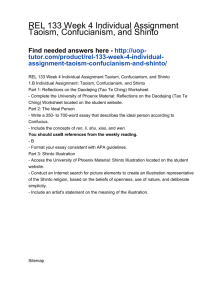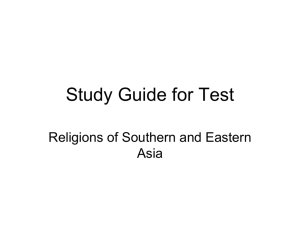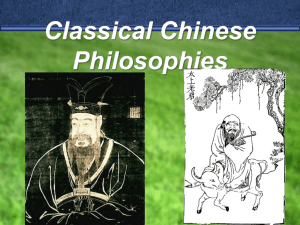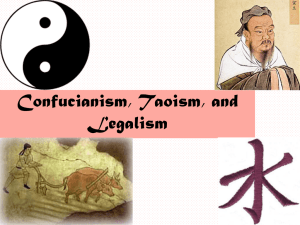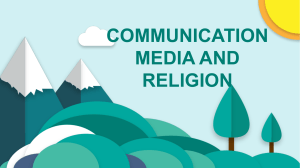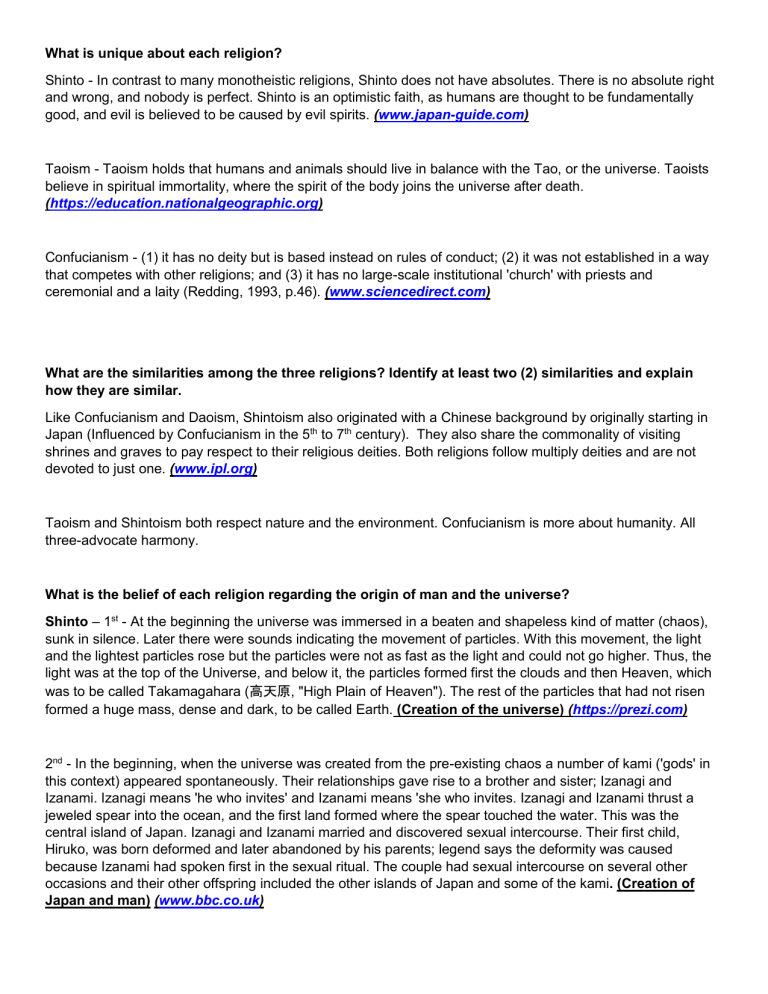
What is unique about each religion?
Shinto - In contrast to many monotheistic religions, Shinto does not have absolutes. There is no absolute right
and wrong, and nobody is perfect. Shinto is an optimistic faith, as humans are thought to be fundamentally
good, and evil is believed to be caused by evil spirits. (www.japan-guide.com)
Taoism - Taoism holds that humans and animals should live in balance with the Tao, or the universe. Taoists
believe in spiritual immortality, where the spirit of the body joins the universe after death.
(https://education.nationalgeographic.org)
Confucianism - (1) it has no deity but is based instead on rules of conduct; (2) it was not established in a way
that competes with other religions; and (3) it has no large-scale institutional 'church' with priests and
ceremonial and a laity (Redding, 1993, p.46). (www.sciencedirect.com)
What are the similarities among the three religions? Identify at least two (2) similarities and explain
how they are similar.
Like Confucianism and Daoism, Shintoism also originated with a Chinese background by originally starting in
Japan (Influenced by Confucianism in the 5th to 7th century). They also share the commonality of visiting
shrines and graves to pay respect to their religious deities. Both religions follow multiply deities and are not
devoted to just one. (www.ipl.org)
Taoism and Shintoism both respect nature and the environment. Confucianism is more about humanity. All
three-advocate harmony.
What is the belief of each religion regarding the origin of man and the universe?
Shinto – 1st - At the beginning the universe was immersed in a beaten and shapeless kind of matter (chaos),
sunk in silence. Later there were sounds indicating the movement of particles. With this movement, the light
and the lightest particles rose but the particles were not as fast as the light and could not go higher. Thus, the
light was at the top of the Universe, and below it, the particles formed first the clouds and then Heaven, which
was to be called Takamagahara (高天原, "High Plain of Heaven"). The rest of the particles that had not risen
formed a huge mass, dense and dark, to be called Earth. (Creation of the universe) (https://prezi.com)
2nd - In the beginning, when the universe was created from the pre-existing chaos a number of kami ('gods' in
this context) appeared spontaneously. Their relationships gave rise to a brother and sister; Izanagi and
Izanami. Izanagi means 'he who invites' and Izanami means 'she who invites. Izanagi and Izanami thrust a
jeweled spear into the ocean, and the first land formed where the spear touched the water. This was the
central island of Japan. Izanagi and Izanami married and discovered sexual intercourse. Their first child,
Hiruko, was born deformed and later abandoned by his parents; legend says the deformity was caused
because Izanami had spoken first in the sexual ritual. The couple had sexual intercourse on several other
occasions and their other offspring included the other islands of Japan and some of the kami. (Creation of
Japan and man) (www.bbc.co.uk)
Taoism - In the beginning of time, there was only chaos. The elements and gases of the heavens and earth
freely mingled, and the organizing principle was dormant. It lay dormant somewhere inside this elemental
cosmos, awaiting the right moment to begin the transformation. The shape of this primeval mass was
something like an egg.
For 18,000 years the universe remained in this state, until the incubation was finally complete, and the egg
hatched. Then the heavens and the earth came into existence. The lighter, most pure substances floated
upward and became the heavens. These elements were named yang. The heavier, more impure substances
descended and became the earth. These were named yin.
From the same forces, a third, the giant Pan Ku, was born as well. As he grew, his sheer size divided the
heavens and the earth. The giant lived for another 18,000 years. With the assistance of four creatures, a
tortoise, a phoenix, a dragon, and a unicorn, he labored daily to mold the earth. Together they created the
world as we know it today.
When Pan Ku finally died, his body was transformed. His left eye became the sun and his right eye became
the moon. His blood became the rivers and oceans, his breath became the wind, his sweat became the rain,
and his voice became the thunder. His flesh became the soil, and from the fleas living on his body, the human
race sprang into being. In this way, the stage was set for the pageant of history to unfold.
(www.britannica.com)
Confucianism - Confucianism is a moral and social framework developed by the Chinese philosopher and
government official, Confucius. Confucianism provides a set of principles explaining how moral individuals
should act. It is grounded in values such as respect of hierarchies and filial piety. Confucianism is not a
succinct religion and the followers of different faiths, such as Shintoism and Buddhism, can also support
Confucian principles. Because of its focus upon the appropriate conduct of human beings, Confucianism does
not offer a succinct creation myth. The behavior of the gods or other supernatural beings did not really interest
Confucius and are discussed only tangentially as a springboard for the discussion of persons.
(www.brittanica.com)
How does each religion identify what is good or bad (morality)?
Shintoism - Shinto has no moral absolutes and assesses the good or bad of an action or thought in the
context in which it occurs: circumstances, intention, purpose, time, location, are all relevant in assessing
whether an action is bad. (www.bbc.co.uk)
Taoism - In practice Taoism recommends the same sorts of moral behavior to its followers as other religions. It
disapproves of killing, stealing, lying and promiscuity, and promotes altruistic, helpful and kindly behavior.
(www.bbc.co.uk)
Confucianism - The main idea of Confucianism is the importance of having a good moral character, which can
then affect the world around that person through the idea of “cosmic harmony.” If the emperor has moral
perfection, his rule will be peaceful and benevolent. Natural disasters and conflict are the result of straying from
the ancient teachings. This moral character is achieved through the virtue of ren, or “humanity,” which leads to
more virtuous behaviors, such as respect, altruism, and humility. Confucius believed in the importance of
education in order to create this virtuous character. He thought that people are essentially good yet may have
strayed from the appropriate forms of conduct. Rituals in Confucianism were designed to bring about this
respectful attitude and create a sense of community within a group.
(www.education.nationalgeographic.org)
What is the belief of each religion regarding the purpose of life?
Shinto - The purpose of life in Shinto is to enjoy and value nature's beauty, observe rituals, and show
allegiance to one’s family, group, community, and to the kami of the area in which one was born, or the kami
worshiped by one’s ancestors. (http://medium.com)
Taoism - The purpose of human beings is then to live life according to the Tao, which requires passivity,
calmness and non-strife, known by Taoists as 'Wu Wei' (Table 1.3). The ineffable, eternal, creative reality is
the source and end of all things. The Taoist prefers a life of total inactivity. (www.sciencedirect.com)
Confucianism - In Confucianism man is the center of the universe: man cannot live alone, but with other
human beings. For human beings, the ultimate goal is individual happiness. The necessary condition to
achieve happiness is through peace. (www.qcc.cuny.edu)
Belief in destiny
Shintoism - Shinto believe that a person's destiny is to live their life improving and helping to develop Japan to
the best country it can be. They believe that their destiny is to help Japan in any way that they can. And, when
they die, as a spirit they will help guide their relatives and loved ones to do the same. (www.prezi.com)
Taoism - A Daoist destiny was mortgaged from birth – by guilt inherited from the past, debts owed to one’s
parents, and the initial endowment of vitality. To live meant to inexorably augment the original burden.
Accumulated liabilities accounted for suffering, disease, and ill fortune met with in this world. They presaged a
diminished life span and an adverse afterlife. To ransom destiny was to make amends for liabilities incurred
through a person’s own fault or by exposure to external malignant forces. (www.princeton.edu)
Confucianism - The Confucian idea of “ming (destiny)” holds that in the course and culmination of human life,
there exists some objective certainty that is both transcendent and beyond human control. This is a concept of
ultimate concern at the transcendental theoretical level in Confucianism. During its historical development,
Confucianism has constantly offered humanist interpretations of the idea of “destiny”, thinking that the
transcendence of “destiny” lies inherently within the qi endowment and virtues of human beings, that the
certainty of “destiny” is in essence contingency at the beginning of life and linear irreversibility towards its end,
and that to live in light of ethics and physical rules — having a “commitment to human affairs” — means putting
“destiny” into practice. As all these facts show, the Confucian ultimate concern regarding human life is full of
rational awareness. (link.springer.com)
How do they view women?
Shintoism - Women occupy a unique role in the indigenous Japanese traditions of Shinto, including a unique
form of participation as temple stewards and shamans, or miko. Though a ban on female Shinto priests was
lifted during World War II, the number of women priests in Shinto is a small fraction of contemporary clergy.
Women in Shinto often appear as miko, shrine maidens who are consistently seen as conduits between spirits
and men, though men are then seen as the actors who implement the will of the spirit.
(https://slife.org/women-in-shinto/)
Taoism - From the authors' assessment of the history of Daoism, five fundamental notions about the roles of
women have emerged: (1) the mother as the universe's life-giving and nurturing force; (2) women as a symbol
of the cosmic force of yin, which perfectly balances the male yang; (3) women as acknowledged educators in
the esoteric activities of religious Daoism; (4) women as proprietors of enabling otherworldly techniques who
possess the wisdom to use them; and (5) women as the (p. 5). Although these positions have taken on diverse
forms throughout history, a thorough understanding of the significance of women's presence in Daoism
necessitates a critical assessment of each. (www.muse.edu)
Confucianism - Confucianism is often associated with oppressing women, whether that be subjugating
women to their fathers during childhood, husbands during marriage, or sons during widowhood. Oppressive
acts associated with Confucian principles also include foot binding, concubinage, and widow suicide.
(www.shcwartmanscholars.com)
For Confucianism in Han China's views on women: - Filial piety required that people respect their elders and
ancestors, especially male ones. - The ideal role for a woman was to take care of a large household. - Women
typically didn't have formal roles in Confucian life outside the home. (www.khanacademy.org)
